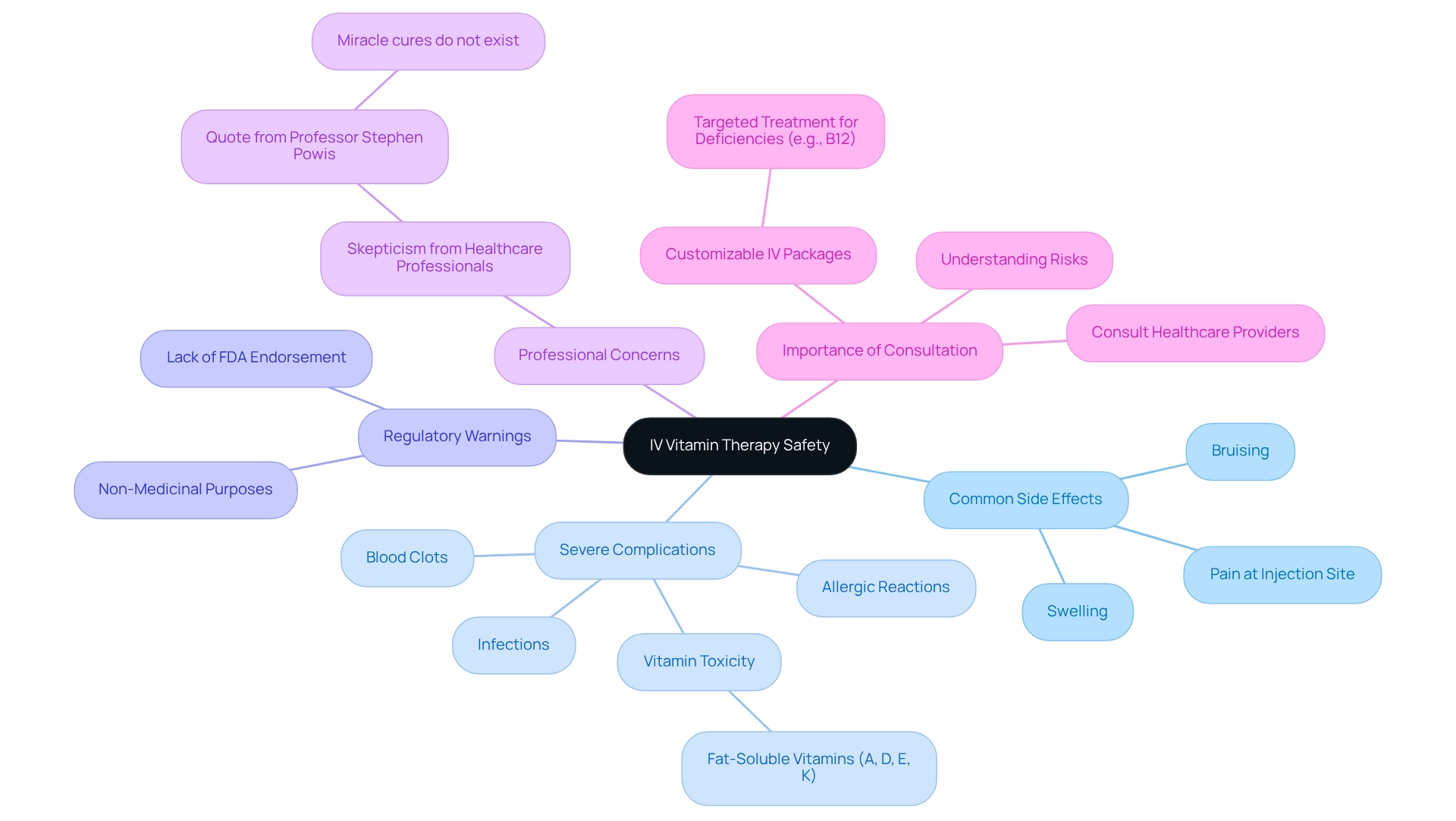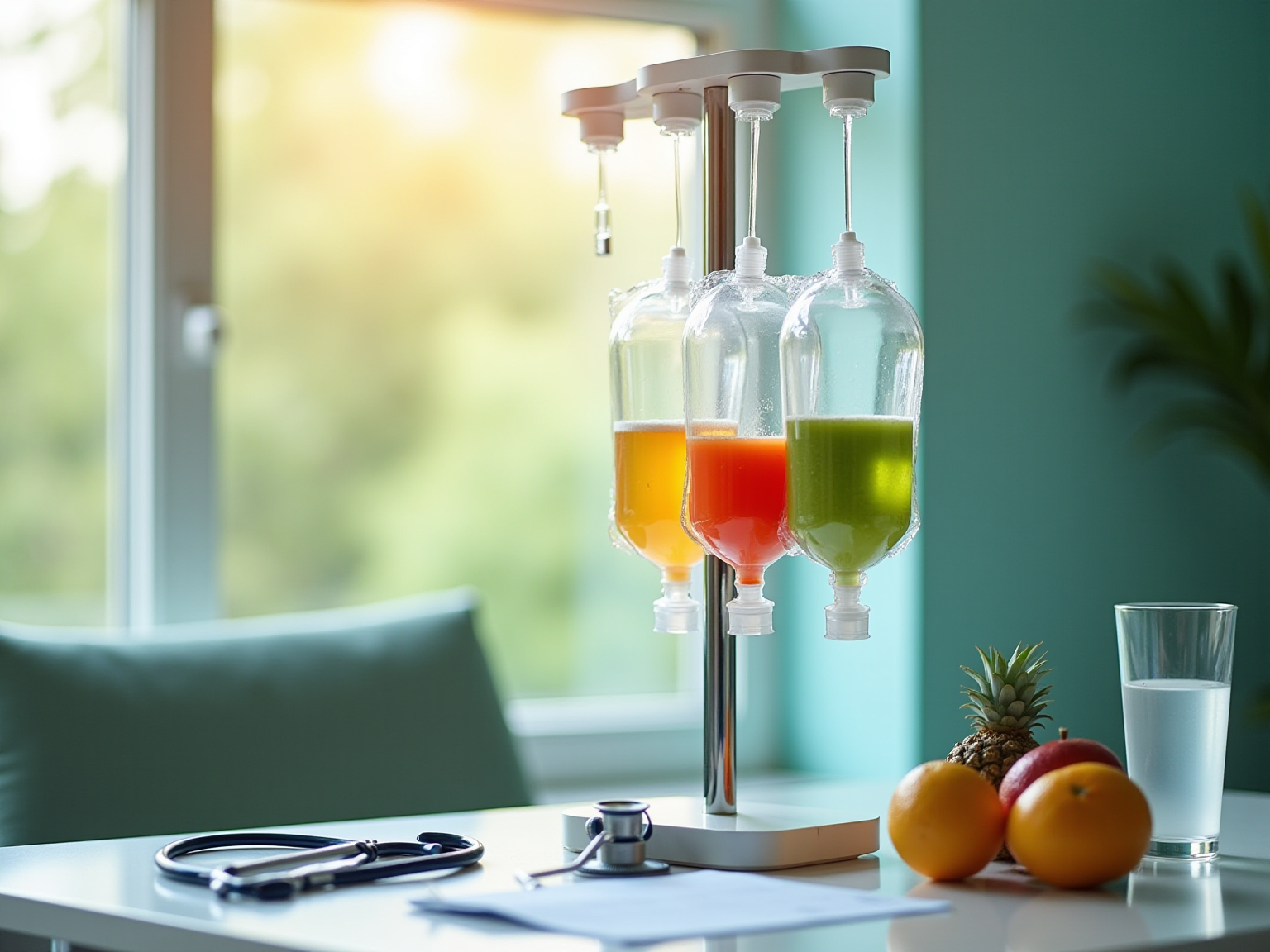Are Vitamin Infusions Safe? Comparing Risks and Benefits
Overview
Vitamin infusions, also known as IV nutrient therapy, offer the potential for rapid nutrient absorption and may provide benefits for specific health conditions. However, safety concerns arise due to possible side effects and complications.
While IV therapy can be advantageous for individuals facing absorption issues or those in need of recovery, it is crucial to recognize the associated risks. These may include infections and vitamin toxicity, which underscores the importance of consulting healthcare professionals before pursuing treatment.
In conclusion, if you are considering vitamin infusions, it is essential to weigh the potential benefits against the risks. Engaging with a healthcare provider can ensure that you make an informed decision tailored to your health needs.
Introduction
The rise of IV vitamin therapy has ignited considerable interest among health enthusiasts and those in search of alternative wellness solutions. This innovative treatment delivers essential vitamins and minerals directly into the bloodstream, promising rapid absorption and immediate benefits, such as increased energy and improved immune function. As more individuals explore the potential of this therapy, discussions surrounding its effectiveness, safety, and suitability have intensified.
While some advocate for its advantages, others caution against the risks and the lack of comprehensive research. This article delves into the multifaceted world of IV vitamin therapy, examining its purpose, safety concerns, comparisons with alternative treatments, and recommendations for those considering this approach to health and wellness.
Understanding IV Vitamin Therapy: Definition and Purpose
IV nutrient therapy, or intravenous micronutrient therapy, involves the direct administration of supplements and minerals into the bloodstream via an IV drip. This method bypasses the digestive system, facilitating rapid nutrient absorption. Frequently advertised for numerous wellness advantages, it promises enhanced energy levels, better immune function, and relief from exhaustion or dehydration. Advocates suggest that this direct delivery system can achieve higher concentrations of vitamins compared to oral supplements, making it particularly beneficial for individuals with specific health issues or those seeking immediate results.
The IV hydration market has experienced substantial growth, reflecting an increasing interest in the potential benefits among health-conscious individuals. This interest is echoed in discussions on platforms like ByKomi.com, where users engage in conversations about innovative anti-aging strategies, including the role of quality nutrition and dietary supplements. However, the scientific evidence backing these claims raises questions about whether vitamin infusions are safe, warranting a thorough evaluation of the treatment’s effectiveness and limitations.
Recent studies have highlighted the advantages of intravenous micronutrient treatment, including its ability to cleanse the body naturally and eliminate toxins, which can contribute to a more youthful appearance. As noted by Grand View Research, “they cleanse the body naturally and remove toxins to give a youthful appearance to the skin.” Health professionals emphasize that IV treatment can be especially beneficial for individuals who have difficulty with nutrient absorption due to gastrointestinal problems or those with heightened nutritional requirements, such as athletes or individuals recuperating from illness.
Real-world examples illustrate the advantages of the treatment, with many users reporting increased energy levels and better overall well-being after sessions. Personal experiences shared on ByKomi.com further highlight the positive influence of dietary supplements and innovative treatments in anti-aging discussions. However, it is essential to consider the limitations of IV nutrient treatment, including potential side effects and whether vitamin infusions are safe, given the lack of comprehensive research on long-term effectiveness. As the debate between IV treatment and oral supplements continues to gain traction in health discussions, individuals should weigh both the potential advantages and the limitations of intravenous micronutrient administration before making informed decisions about their health.
Evaluating the Safety of IV Vitamin Therapy: Risks and Side Effects
Evaluating the Safety of IV Vitamin Therapy: Risks and Side Effects
IV vitamin therapy has surged in popularity, touted for its convenience and perceived effectiveness. However, it is crucial to recognize that the question of whether vitamin infusions are safe is important, as this treatment is not without its risks. Common side effects include bruising, swelling, and pain at the injection site.
More severe complications can occur, such as infections, blood clots, and allergic reactions to the substances infused. Notably, high doses of certain vitamins, particularly fat-soluble ones like A, D, E, and K, can lead to toxicity, raising further concerns about safety.
Additionally, while human growth hormone (GH) therapy offers numerous benefits, it is important to be aware of its potential side effects, which may include joint pain, swelling, insulin resistance, and an increased risk of diabetes. Long-term use of GH therapy may also be associated with an elevated risk of certain cancers. This emphasizes the importance of safe practices, including supervision, monitoring, and dosage management when considering such treatments.
The Medicines and Healthcare Products Regulatory Agency has issued warnings regarding the use of IV drips, emphasizing that they are intended for non-medicinal purposes only. The absence of FDA endorsement for numerous IV nutrient therapies raises questions about whether vitamin infusions are safe, emphasizing the need for caution as unregulated practices may lead to serious complications.
Healthcare professionals have expressed concerns about whether vitamin infusions are safe due to the possible side effects of intravenous nutrient infusions. Professor Stephen Powis, NHS England’s medical director, cautions that “miracle hangover cures and quick fixes simply don’t exist,” underscoring the importance of understanding the risks involved.
Real-life examples illustrate the complications that can arise from these treatments. For instance, adjustable IV packages can be designed to address particular health requirements, such as incorporating B12 for individuals who are lacking. While this customization allows for targeted treatment, it also underscores the importance of professional oversight to mitigate risks associated with such practices.
In summary, while IV nutrient treatment may offer benefits, individuals should consult healthcare providers to fully understand if vitamin infusions are safe and the potential side effects and safety risks associated with these interventions.

Comparing IV Vitamin Therapy with Alternative Wellness Treatments: Benefits and Limitations
In assessing whether vitamin infusions are safe compared to other wellness approaches like oral supplements and dietary changes, several critical factors arise. Oral supplements are widely available and typically regarded as safe; however, they often lack the prompt effects linked with IV treatment. For instance, IV therapy can deliver high doses of Vitamin C directly into the bloodstream, maximizing absorption and therapeutic benefits, which leads to the question of whether vitamin infusions are safe compared to the gastrointestinal side effects commonly experienced with oral intake. Furthermore, your IV package can be modified to fulfill specific requirements, enabling a customized approach to personal wellness.
Dietary modifications, especially those that emphasize nutrient-rich foods, can provide substantial long-term wellness advantages. A diet abundant in high-quality animal-based foods, akin to the eating habits of the Hunza people, can improve overall well-being and vitality, acting as a sustainable strategy for wellness without the dangers associated with intravenous delivery. The Hunza tribe, recognized for their extraordinary longevity, frequently credits their well-being to a diet rich in premium animal products, which may aid anti-aging endeavors. Furthermore, research shows that dietary changes can be as effective as intravenous treatments in certain situations, especially for enhancing the immune system and energy levels.
Other intravenous interventions, such as hydration support, concentrate mainly on fluid replenishment rather than nutrient delivery, rendering them appropriate for particular health conditions like dehydration or recovery from illness. In contrast, treatments such as the Myers Cocktail IV, which combines Vitamin C, B vitamins, Magnesium, and Glutathione, raise the important question of whether vitamin infusions are safe, as they have demonstrated higher absorption rates than standard daily multivitamins, making them an attractive choice for individuals seeking immediate immune and energy support. The results of the Myers Cocktail IV treatment emphasize its efficacy in delivering vital nutrients that can improve overall health.
Additionally, it is significant to mention that mobile IV services are usually restricted to metropolitan regions and may incur a greater expense, which could be a factor for individuals assessing their choices. IV treatment is also available for headache and migraine relief in the Rockies, highlighting its particular therapeutic uses.
Ultimately, the choice between these alternatives should be guided by personal wellness objectives, current medical conditions, and advice from healthcare experts. Each method has its distinct benefits and drawbacks, and comprehending these can enable people to make educated decisions regarding their well-being and wellness strategies.
Who Should Consider IV Vitamin Therapy? Suitability and Recommendations
Intravenous (IV) nutrient treatment offers significant benefits for individuals facing medical issues that hinder nutrient absorption, particularly gastrointestinal disorders such as Crohn’s disease and ulcerative colitis. These conditions often necessitate alternative approaches to nutrient administration, making IV treatment a viable option for ensuring that essential nutrients and minerals are adequately supplied. In fact, IV treatment effectively addresses the nutritional needs associated with these digestive tract disorders. Furthermore, individuals recovering from surgery or illness can greatly benefit from the rapid replenishment of nutrients provided by IV infusions.
Athletes, in particular, may find IV nutrient therapy advantageous for enhancing recovery after intense training sessions. Customized IV packages can be tailored to meet specific requirements, such as incorporating B12 for those who may be deficient. This focused treatment approach is crucial for optimizing both performance and recovery. A compelling case study on the customization of IV packages illustrates how this method can effectively cater to individual wellness needs, ensuring that athletes receive the nutrients necessary to perform at their peak.
However, it is important to note that when considering IV vitamin treatment, one must ask if vitamin infusions are safe for everyone. Individuals with specific medical conditions, including kidney disease or heart issues, should avoid this treatment due to potential complications. Therefore, it is essential for anyone considering IV treatment to consult with a healthcare professional to evaluate their wellness condition and to determine if vitamin infusions are safe for their needs.
As of 2025, the demographics of individuals utilizing IV vitamin treatment include a diverse array of health-conscious individuals, athletes, and those with specific medical conditions. Expert recommendations highlight the necessity of a comprehensive assessment before proceeding with IV therapy, ensuring that it aligns with the individual’s health needs and objectives. As Justine Johnstone Wange noted, “Intravenous Therapy Was Expanded By Italian Physician Guido Baccelli In The Late 1890s And Further Developed In The 1930s By Samuel Hirschfeld, Harold T. Hyman And Justine Johnstone Wange But Was Not Widely Available Until The 1950s,” emphasizing the historical significance and evolution of this treatment option.
Conclusion
The exploration of IV vitamin therapy unveils a complex landscape filled with potential benefits and significant risks. This innovative treatment promises rapid nutrient absorption and immediate health benefits, such as increased energy and improved immune function. However, it is essential to approach it with caution. The therapy can be particularly advantageous for individuals with specific health conditions that impair nutrient absorption, such as gastrointestinal disorders or those recovering from illness. Yet, safety concerns—including potential side effects and the lack of comprehensive research on long-term efficacy—cannot be overlooked.
In comparison, traditional oral supplements and dietary modifications present safer, more accessible alternatives for many individuals. While these methods may deliver results more slowly, they provide a sustainable approach to health that emphasizes the importance of a well-rounded diet. Evidence suggests that dietary changes can yield significant health benefits, akin to those claimed by IV therapy, particularly in promoting immune function and overall vitality.
Ultimately, the decision to pursue IV vitamin therapy should be made with careful consideration and professional guidance. By understanding the unique advantages and limitations of this therapy, as well as alternative wellness treatments, individuals can empower themselves to make informed choices about their health. As the conversation around IV vitamin therapy continues to evolve, prioritizing safety and effectiveness is crucial, ensuring that any approach aligns with personal health goals and medical advice.
Frequently Asked Questions
What is IV nutrient therapy?
IV nutrient therapy, or intravenous micronutrient therapy, involves the direct administration of supplements and minerals into the bloodstream via an IV drip, bypassing the digestive system for rapid nutrient absorption.
What are the claimed benefits of IV nutrient therapy?
Advocates claim that IV nutrient therapy enhances energy levels, improves immune function, and provides relief from exhaustion or dehydration. It is also suggested to achieve higher concentrations of vitamins compared to oral supplements.
Who might benefit from IV nutrient therapy?
It may be particularly beneficial for individuals with specific health issues, those who have difficulty with nutrient absorption due to gastrointestinal problems, athletes, or individuals recuperating from illness.
How has the IV hydration market changed recently?
The IV hydration market has experienced substantial growth, reflecting increasing interest among health-conscious individuals in the potential benefits of IV nutrient therapy.
What does the scientific evidence say about IV nutrient therapy?
The scientific evidence supporting the claims of IV nutrient therapy raises questions about its safety and effectiveness, indicating a need for thorough evaluation.
What are some reported real-world experiences with IV nutrient therapy?
Many users report increased energy levels and better overall well-being after sessions, with personal experiences shared on platforms like ByKomi.com highlighting its positive influence.
What limitations should be considered regarding IV nutrient therapy?
Limitations include potential side effects and concerns about the safety of vitamin infusions, as well as the lack of comprehensive research on long-term effectiveness.
How does IV nutrient therapy compare to oral supplements?
The debate between IV treatment and oral supplements continues, with individuals encouraged to weigh both the potential advantages and limitations of intravenous micronutrient administration before making health decisions.






